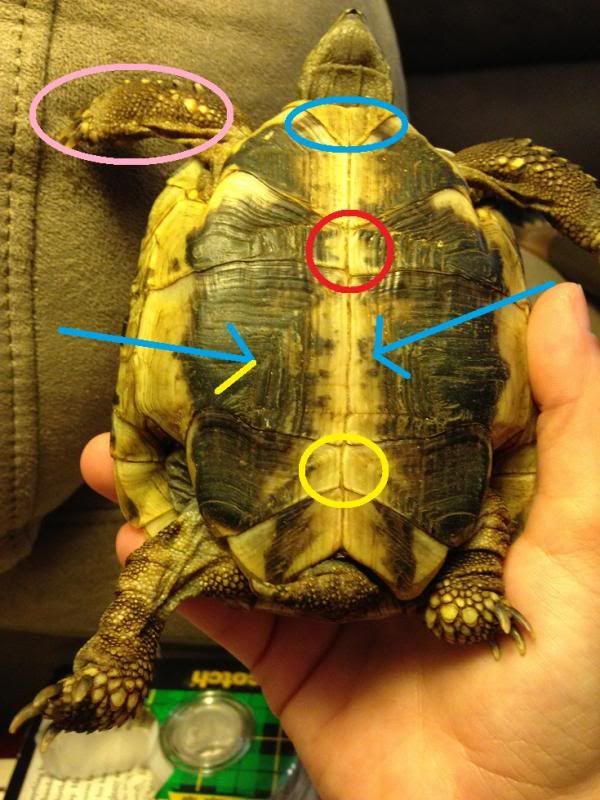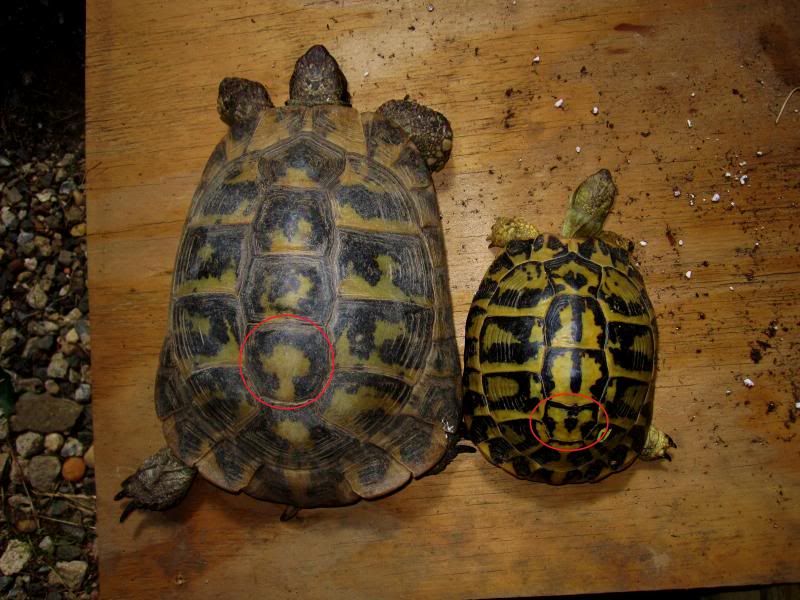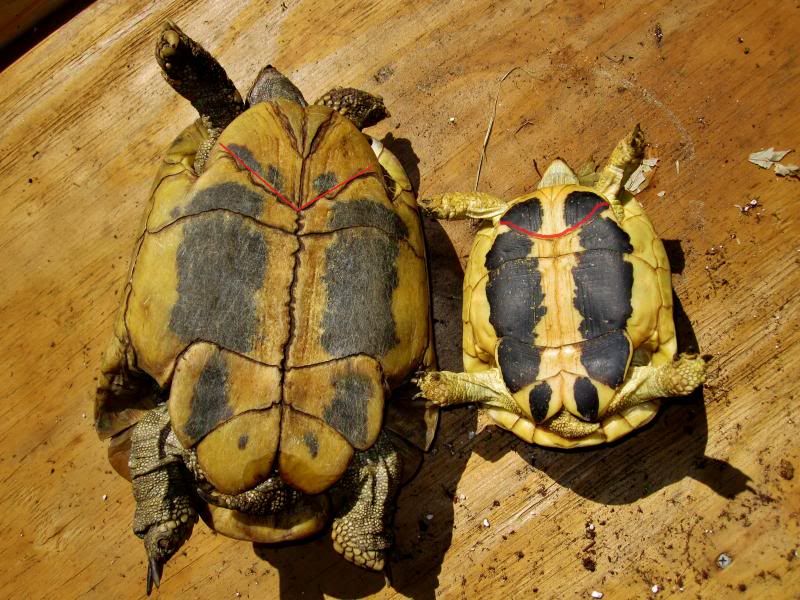You are using an out of date browser. It may not display this or other websites correctly.
You should upgrade or use an alternative browser.
You should upgrade or use an alternative browser.
hermanni or boettgeri?
- Thread starter HerpMS
- Start date
- Joined
- Sep 7, 2007
- Messages
- 2,125
That appears to be a definite hybrid (T. h. hermanni X T. h. boettgeri). It is in noway a pure hermanni. Cool looking animal though.
AW: RE: hermanni or boettgeri?
I loved your new identification video! Could you explain based on which traits you identified this animal as a hybrid?
HermanniChris said:That appears to be a definite hybrid (T. h. hermanni X T. h. boettgeri). It is in noway a pure hermanni. Cool looking animal though.
I loved your new identification video! Could you explain based on which traits you identified this animal as a hybrid?
- Joined
- Sep 7, 2007
- Messages
- 2,125
Glad you liked it! Give me a little bit cause I'm not home but I'll download the photos you posted and highlight the traits I'm talking about.
- Joined
- Sep 7, 2007
- Messages
- 2,125
Ok, here are your photos with the highlighted areas and I will describe in each image what I am talking about. In the end, DNA is the only 100% accurate way to know these things for sure but this a nice "free" version of that lol.
Photo 1:

I have outlined in red triangles the first sign of this animal definitely not being a hermanni. The ground color is horn, drab or cream colored. This is only found in hybrids and boettgeri/hercegovinensis. Never in hermanni which are vibrant true yellow to gold, fluorescent yellow-green or orange-ish.
I have also circled in yellow, the occlusions or bleeding of grey-black spotting/blotching, lightly showing through the ground color. While some hermanni or boettgeri can have some shading showing through during growing, it does not appear in this way. As hermanni reach sub-adult size they lose any brown areas and become only 2 colors, black and yellow, nothing else. The yellow can be various shades as I mentioned above, but there is no bleeding of anything into it.
Photo 2:

Here I circle in red the 5th vertebral scute (V-5). On a T. h. hermanni, a more or less distinct keyhole symbol will always be present on this scute. This symbol can take on various "looks" as I show on www.hermannihaven.com but it will never look as it does in this animal you have. In fact, even in boettgeri this scute is usually a little more distinctive than this.There is no design to the V-5 in your animal which is again a sign of a true hybrid.
I also show a green arrow pointing to the 4th vertebral scute on your tortoise (V-4). On hermanni this scute almost always has a dark central spot on this scute that may or may not be connected to the surrounding dark pigment that borders the scute. In boettgeri, this scute is usually lacking a central spot. Now, it should be noted that T. h. hermanni that derive from Tuscany, Italy can and do lack this central spot on V-4 only sometimes. It is a trait specific to that locality and is pretty much not found in any other pure hermanni locales. However, even though Tuscan hermanni can lack the spot, every single other trait assigned to the Western race is present in them and they show no sign of hybridization...when they are pure of course.
Photo 3:

This image is what really gave it away. The left blue arrow points to this. Those black bands on the plastron do not resemble that of a pure T. h. hermanni. The black pigment is way off in contrast meaning it is not intense enough or well defined.
The right blue arrow points to the messy-ness or spotting from the black bands. This is only found in some hermanni in nature and again it is BLACK not faint and never as abundant.
In blue, I circle the gular scutes. You can see those occlusions or bleed-throughs again faintly. This is a trait of a hybrid or sometimes a trait of boettgeri. Hermann's can and do have pigment on the gulars but it is always a clear black spot or blotch, not an occlusion.
In red I circle the pectoral scute seam and in yellow I circle the femoral scute seem. In pure hermanni, the femoral is almost always longer than the pectoral. It's considered one of the tell-tale, classic traits assigned to the subspecies. What your tortoise is showing is a pectoral seam that is greater than the femoral seam thus alluding to boettgeri or a hybrid.
Lastly, I circle the left limb in pink. The color of the leg and the heavier scalation is a trait of boettgeri or a hybrid. It's darker overall, more brown, with thich, larger scales.
I hope this all helps!
Photo 1:

I have outlined in red triangles the first sign of this animal definitely not being a hermanni. The ground color is horn, drab or cream colored. This is only found in hybrids and boettgeri/hercegovinensis. Never in hermanni which are vibrant true yellow to gold, fluorescent yellow-green or orange-ish.
I have also circled in yellow, the occlusions or bleeding of grey-black spotting/blotching, lightly showing through the ground color. While some hermanni or boettgeri can have some shading showing through during growing, it does not appear in this way. As hermanni reach sub-adult size they lose any brown areas and become only 2 colors, black and yellow, nothing else. The yellow can be various shades as I mentioned above, but there is no bleeding of anything into it.
Photo 2:

Here I circle in red the 5th vertebral scute (V-5). On a T. h. hermanni, a more or less distinct keyhole symbol will always be present on this scute. This symbol can take on various "looks" as I show on www.hermannihaven.com but it will never look as it does in this animal you have. In fact, even in boettgeri this scute is usually a little more distinctive than this.There is no design to the V-5 in your animal which is again a sign of a true hybrid.
I also show a green arrow pointing to the 4th vertebral scute on your tortoise (V-4). On hermanni this scute almost always has a dark central spot on this scute that may or may not be connected to the surrounding dark pigment that borders the scute. In boettgeri, this scute is usually lacking a central spot. Now, it should be noted that T. h. hermanni that derive from Tuscany, Italy can and do lack this central spot on V-4 only sometimes. It is a trait specific to that locality and is pretty much not found in any other pure hermanni locales. However, even though Tuscan hermanni can lack the spot, every single other trait assigned to the Western race is present in them and they show no sign of hybridization...when they are pure of course.
Photo 3:

This image is what really gave it away. The left blue arrow points to this. Those black bands on the plastron do not resemble that of a pure T. h. hermanni. The black pigment is way off in contrast meaning it is not intense enough or well defined.
The right blue arrow points to the messy-ness or spotting from the black bands. This is only found in some hermanni in nature and again it is BLACK not faint and never as abundant.
In blue, I circle the gular scutes. You can see those occlusions or bleed-throughs again faintly. This is a trait of a hybrid or sometimes a trait of boettgeri. Hermann's can and do have pigment on the gulars but it is always a clear black spot or blotch, not an occlusion.
In red I circle the pectoral scute seam and in yellow I circle the femoral scute seem. In pure hermanni, the femoral is almost always longer than the pectoral. It's considered one of the tell-tale, classic traits assigned to the subspecies. What your tortoise is showing is a pectoral seam that is greater than the femoral seam thus alluding to boettgeri or a hybrid.
Lastly, I circle the left limb in pink. The color of the leg and the heavier scalation is a trait of boettgeri or a hybrid. It's darker overall, more brown, with thich, larger scales.
I hope this all helps!
Thank you for shared such detail identification rules.
Great to know/learn this. Thanks.
Great to know/learn this. Thanks.
- Joined
- Aug 22, 2013
- Messages
- 196
HermanniChris said:I also show a green arrow pointing to the 4th vertebral scute on your tortoise (V-4). On hermanni this scute almost always has a dark central spot on this scute that may or may not be connected to the surrounding dark pigment that borders the scute. In boettgeri, this scute is usually lacking a central spot.
Thanks for the detailed information, Chris!
Are you sure that the V-4 spot is a reliable sign, though? Most of my young boettgeris have a black spot on that scute. The father has one, the mother doesn't, maybe that's why the children are mixed.
Wow, Chris. Thank you so much for taking the time to do this. Great tutorial!
- Joined
- Sep 7, 2007
- Messages
- 2,125
Yes it's very reliable in adults. Boettgeri can and do have it but they are almost always the ones lacking it. Basically, if a subspecies is going to lack it, it's going to be boettgeri. Except for Tuscan origin, hermanni will usually have it. Your youngsters may actually lose it by the time they are fully grown older adults. I wouldn't be surprised if they do. But, they also may not. The variation in boettgeri is much different than the variation found in hermanni. While variation does heavily occur in populations of hermanni, it's along the lines of things like keyhole shape and size, overall size, hues in the yellow ground colors, number of nails found on each front foot etc....
I don't doubt that you have boettgeri because they can have that black spot on V-4. It's hermanni that really should always have it.
When I talk about these traits, I'm referring to not tens or dozens, I'm talking hundreds of these tortoises from all over their distribution range.
I don't doubt that you have boettgeri because they can have that black spot on V-4. It's hermanni that really should always have it.
When I talk about these traits, I'm referring to not tens or dozens, I'm talking hundreds of these tortoises from all over their distribution range.
Chris, you rock man. You just rock.
Thank you for taking the time to share this with us.
Thank you for taking the time to share this with us.
- Joined
- Sep 7, 2007
- Messages
- 2,125
Thank you guys.
I should add one more thing though...
None of these traits including the spot on V-4 are reliable ALONE. They must be in combination with the rest of the traits. So for example:
If you have a Hermann's tortoise with 2 longitudinal black bands on the plastron that are continuous but the animal doesn't have a keyhole symbol on V-5, a central spot on V-4, a divided supracaudal shield, a sub ocular spot and bright yellow ground color etc etc...guess what? It's not a hermanni.
Here's a helpful comparison photo using one of my boettgeri (left) and one of my hermanni (right). I also show the "V" shape in the seam of where the humeral scutes meet the pectoral scutes on the plastron. In boettgeri it is usually a straight "V" and in hermanni it dips like a "U". HOWEVER, this trait is 100% NOT reliable really at all. Either subspecies can have a V, U or even a zig zag line. Most researchers are doing away with this trait. It's of course still worth mentioning.


I should add one more thing though...
None of these traits including the spot on V-4 are reliable ALONE. They must be in combination with the rest of the traits. So for example:
If you have a Hermann's tortoise with 2 longitudinal black bands on the plastron that are continuous but the animal doesn't have a keyhole symbol on V-5, a central spot on V-4, a divided supracaudal shield, a sub ocular spot and bright yellow ground color etc etc...guess what? It's not a hermanni.
Here's a helpful comparison photo using one of my boettgeri (left) and one of my hermanni (right). I also show the "V" shape in the seam of where the humeral scutes meet the pectoral scutes on the plastron. In boettgeri it is usually a straight "V" and in hermanni it dips like a "U". HOWEVER, this trait is 100% NOT reliable really at all. Either subspecies can have a V, U or even a zig zag line. Most researchers are doing away with this trait. It's of course still worth mentioning.


This is great . It would make a great sticky to add to the one already.
Woah! That was a super detailed explanation! thank you. 
HermanniChris said:Thank you guys.
I should add one more thing though...
None of these traits including the spot on V-4 are reliable ALONE. They must be in combination with the rest of the traits. So for example:
If you have a Hermann's tortoise with 2 longitudinal black bands on the plastron that are continuous but the animal doesn't have a keyhole symbol on V-5, a central spot on V-4, a divided supracaudal shield, a sub ocular spot and bright yellow ground color etc etc...guess what? It's not a hermanni.
Here's a helpful comparison photo using one of my boettgeri (left) and one of my hermanni (right). I also show the "V" shape in the seam of where the humeral scutes meet the pectoral scutes on the plastron. In boettgeri it is usually a straight "V" and in hermanni it dips like a "U". HOWEVER, this trait is 100% NOT reliable really at all. Either subspecies can have a V, U or even a zig zag line. Most researchers are doing away with this trait. It's of course still worth mentioning.


Thank you, THANK YOU!
Great information! ! ! ! ! ! !
Thank you so much for the detailed explanation! I'm sorry it took so long to respond, but I really appreciate the time you took to provide all of this information! I find it so interesting to learn all about these animals and appreciate all the information you all pass down to me as a newbie!
Similar threads
- Locked
- Replies
- 7
- Views
- 16K
- Replies
- 10
- Views
- 2K
New Posts
-
Setting up for a Russian Tortoise - Constructive comments welcome
- Latest: Alex and the Redfoot
-
-
-
-



